It’s been a while since I’ve posted anything about my Kawandi style quilting adventures. Since I was introduced to it by my Quilt Lab cohorts back in January of 2021 I’ve done a bunch of research, made a few things, and taught a class! I was hesitant to teach a class in something that is such an obvious example cultural appropriation, but there is such a demand and I want people to try this amazing quilting technique for themselves. So, here I am, middle-aged white colonist teaching folks about African/Indian hand crafts.
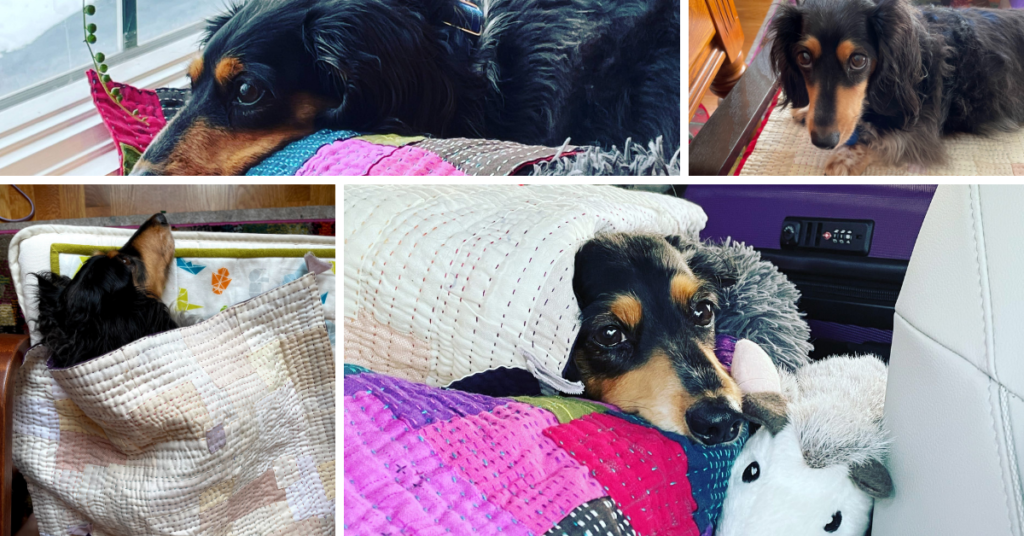
Just so you know, I did agonize over this decision for several months. I was not able to secure a teacher of Kawandi quilting for the shop, so I decided to step in and share my knowledge. I chatted with someone who practices Kawandi quilting in India, and she advised me to just go for it. The population of Kawandi quilters even in India is quite small, and very few people are interested in learning it over there, from her perspective. So, with her blessing, I decided to give it a try. I also decided that I will be donating a portion of my class fees to the African Indian Alliance, a charity that benefits the population that I find to be so inspiring.
Alright. On to the fun stuff. I took a class with Sujatah Shah, and it was lovely. Her class was great – educational and fun. Unfortunately she is quite busy and doesn’t offer classes all that often. If you get a chance, you should absolutely make time to take one with her. I played in that class, using a grouping of nearly white fabrics combined with brightly colored threads. It looks better in person than it does in this photo. This is one of Oscar’s favorite quilts. When we are home, it is in his studio bed. When we travel, it is on the bed where we sleep, and he sleeps on it every night.
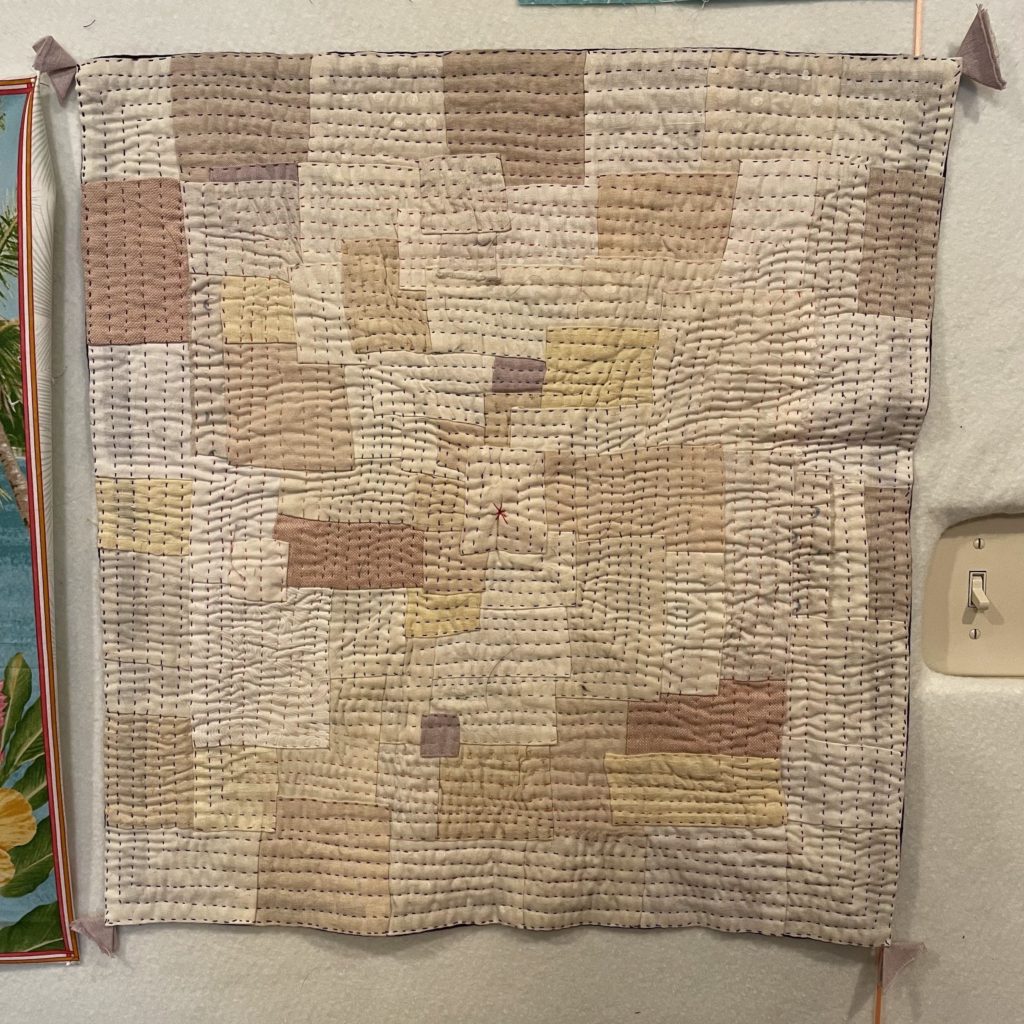
I especially love the back. The colored threads on the purple fabric are a beautiful surprise.
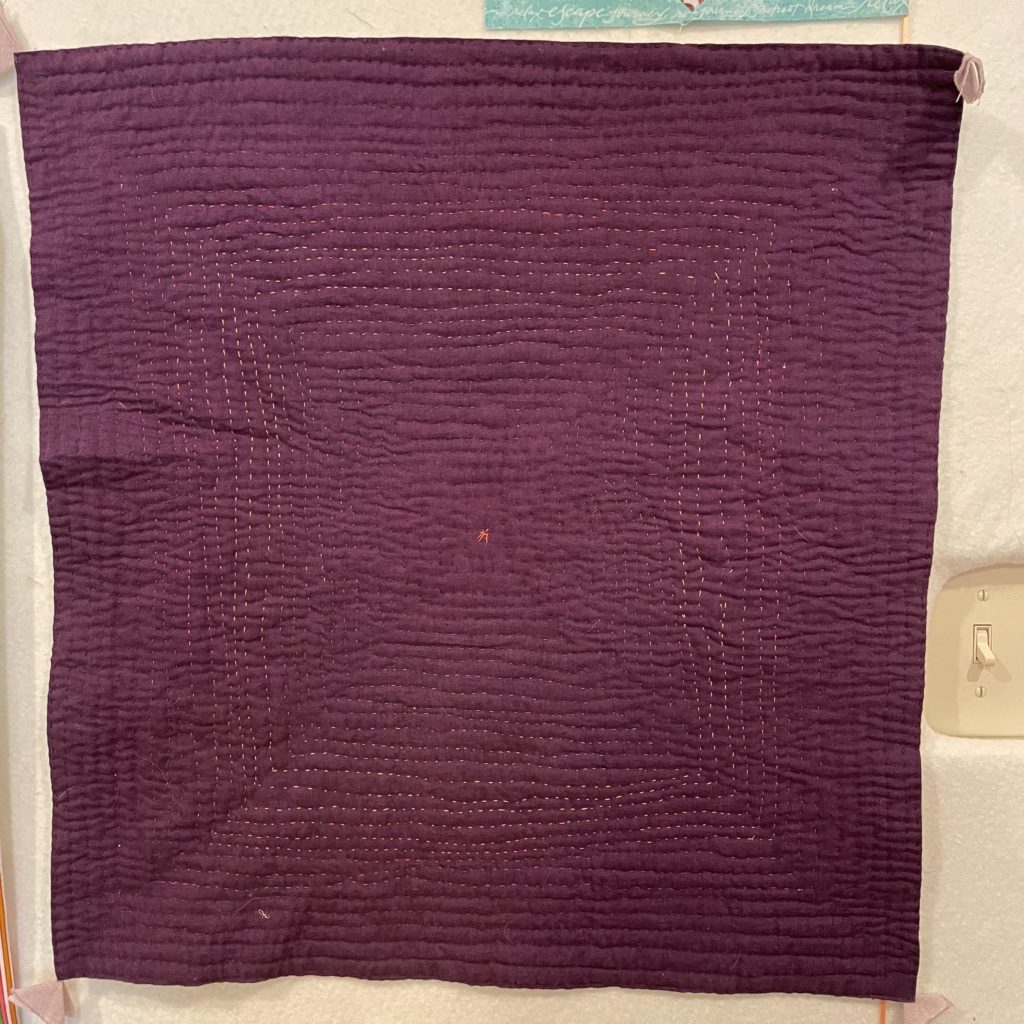
I used a combination of fabrics here – all gathered from my stash. Most are loosely woven things like Essex linen, peppered cottons, or homespuns. The batting is just a scrap of Warm & Natural that was laying around. Sujatah recommends Spagetti thread from Wonderfil, and it is nice to stitch with. Not as chunky as Perle cotton, but still nice and strong, with a satisfactory thick line.
If you notice the little star in the middle – that is not a traditional thing. That is Jen The Control Freak taking extra stitches to smash down a poofy bit of batting. It happens in many of my Kawandi pieces. Another thing you might notice is that my lines are not straight. Almost like I’m not even trying to be straight. I consider these hand stitching pieces to be a way to relax. Y’all – I don’t need another quilt. I’m not making these for a purpose -the making is the purpose. So, I have permission for my stitches to wander, cross over each other, whatever. The beauty is in the texture, which I can’t really communicate in photos.
I’ve been working on this huge piece, too. I don’t make a lot of progress on it, and that is okay. It’s coming along. It gets harder to work with all of the bulk of the outer edge as I go along. What is really slowing me down, though, is that I’ve just got so many other things going on and I don’t spend enough time doing relaxing stitching. It is a fun project to bring on vacation – as long as I pull the pin and needle out of it, it is a convenient throw to use, although a bit odd looking with all of the exposed batting.
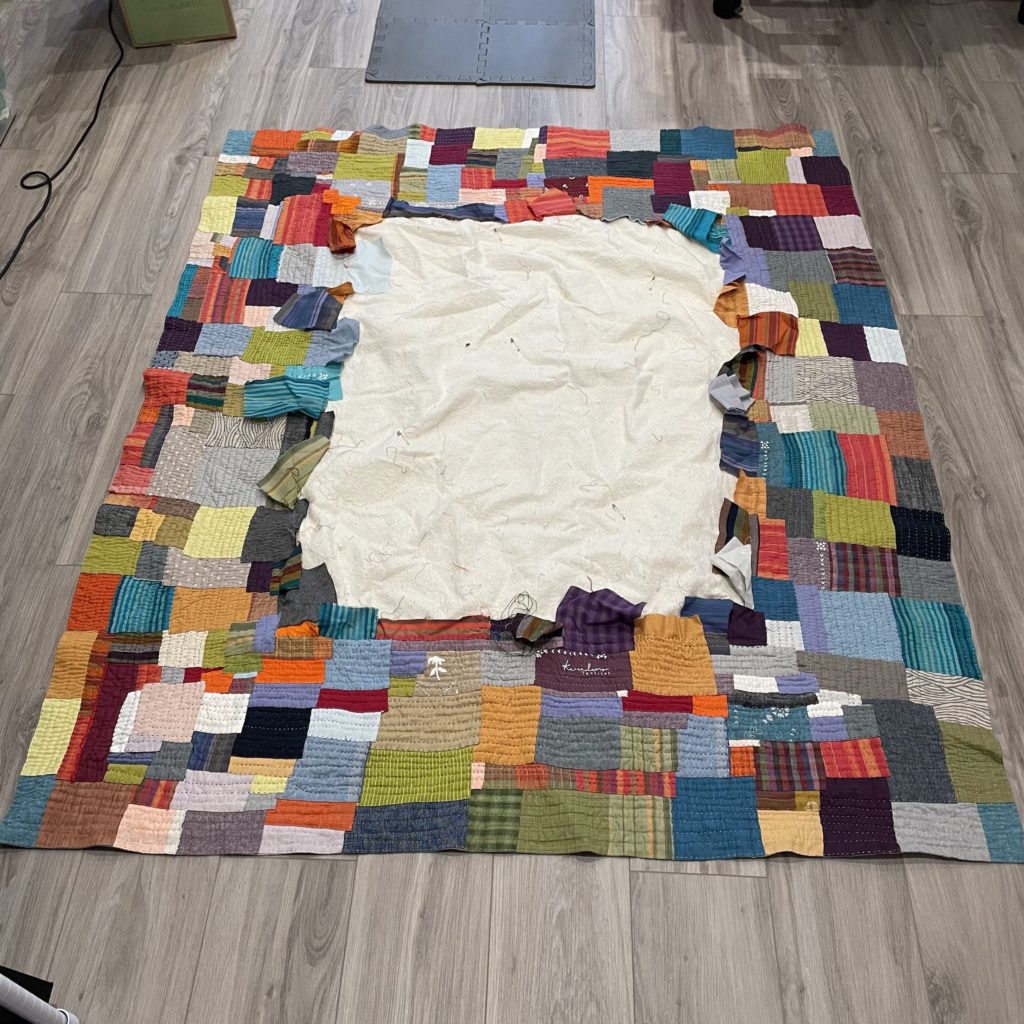
Again, this one is made with scraps of loosely woven fabrics from my stash, along with a scrap bag from Karen Lewis, and some other odds and ends as they come along. It’s fun to watch the fabrics change as the quilt takes shape. I’m using a combination of perle cotton and Spaghetti in this one, because someone (me) tossed them all into the same bag.
This pretty little piece was the example I used for the class I taught. It glows! This fabric is Entwine by Giucy Giuce. My students asked me what I use these little quilts for, which kind of stopped me in my tracks. Mostly I just use them as social media fodder, and then let the dog play with them. I don’t dislike little quilts like I used to, but now I’ve been thinking about more practical applications of my small Kawandi pieces.
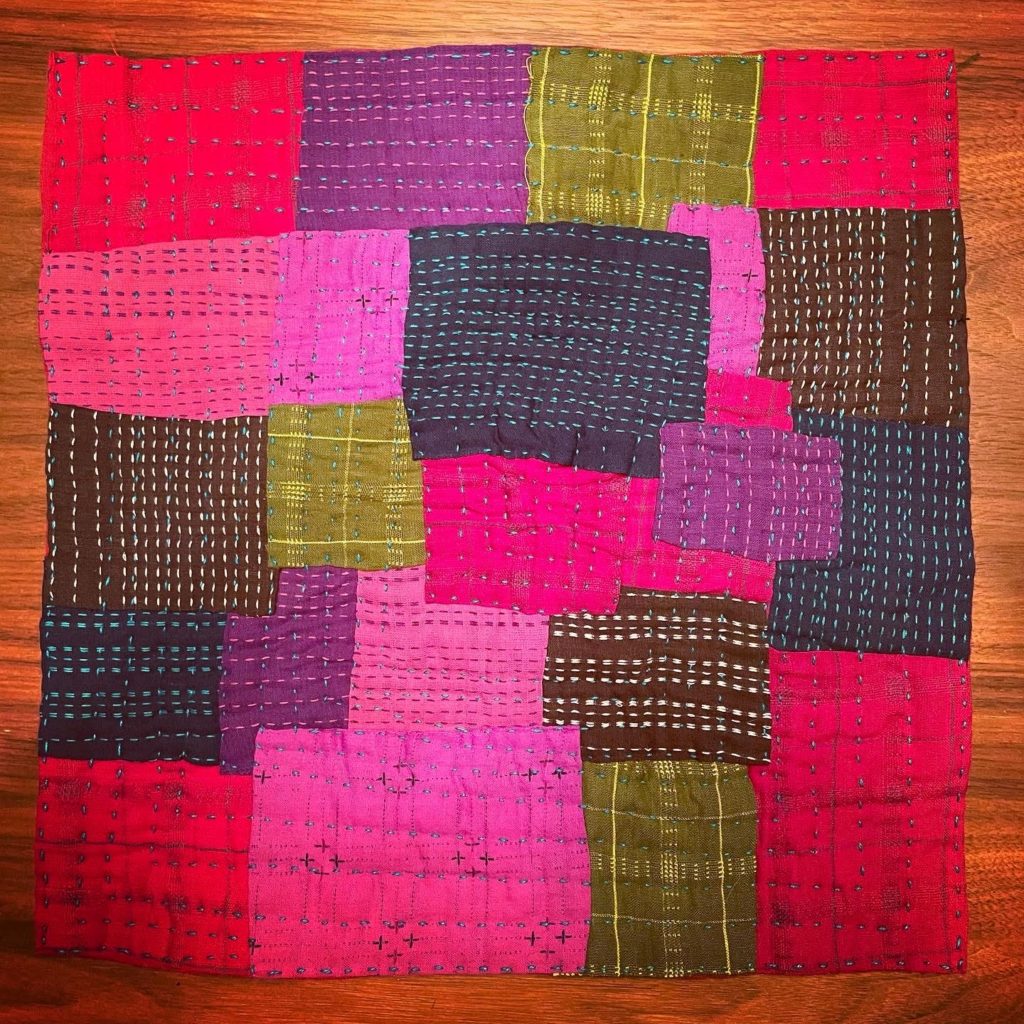
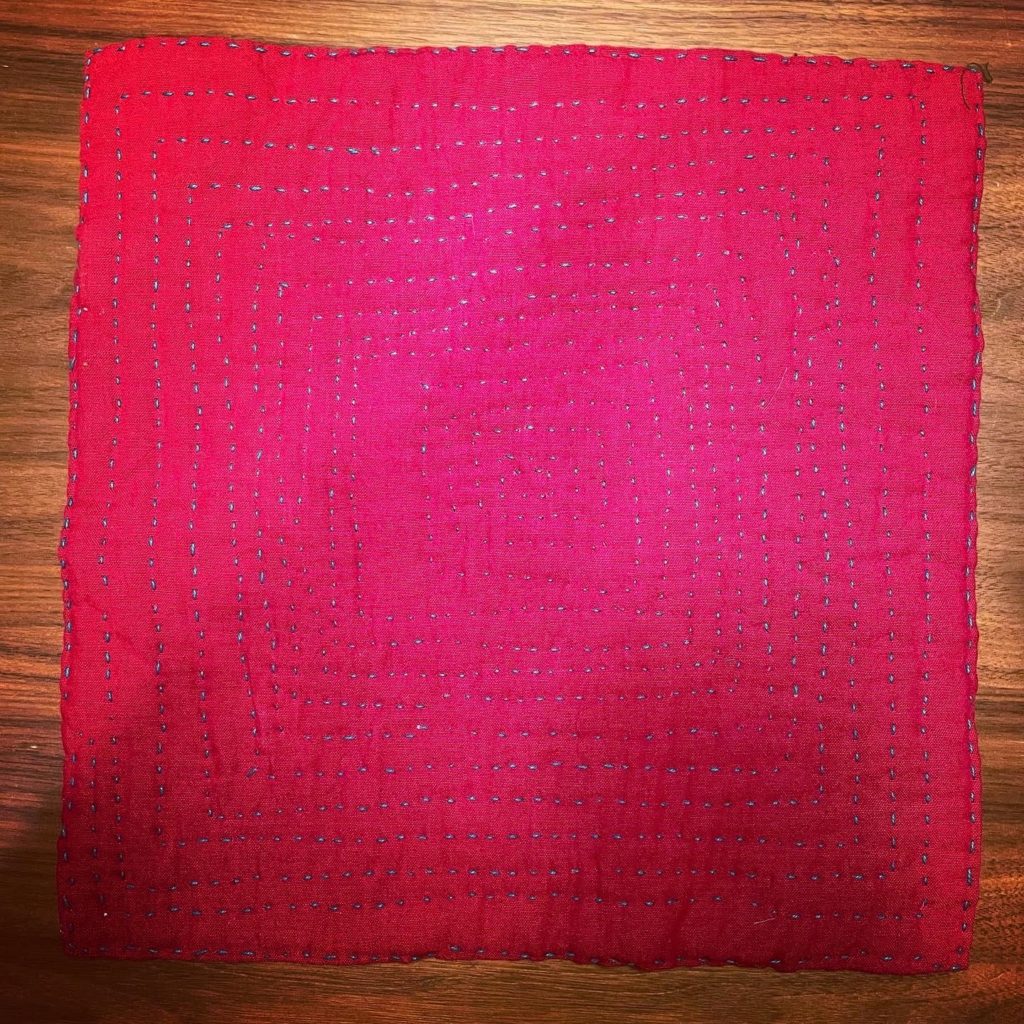
For my next kawandi style quilting classes, I’ll be suggesting a placemat size sample. That is a good, practical use of a small quilt, and my breakfast table would look so fun with a bunch of Kawandi decorating it. I plan to offer my class again in March or April with Gotham Quilts. Just go over to their page and check out Virtual Classes. I’ll also make an announcement in my newsletter once it is on the schedule. I’m kind of fantasizing about being able to offer the class in person this summer.
My previous post on Kawandi Quilting has more info on the history of the craft. It also shows the machine stitched samples I played with. They are loads of fun.
Key Supplies for Kawandi
Have you tried Kawandi Style quilting yet?


Please let me know when the Kawandi class will be as I’m very interested in taking it.
Hi Jennifer, my name too, I have started this method of Kawandi quilting and I have been wondering how do you manage the centre for stitching?
Hi! The center bulk just kind of disappears as I stitch it down. If there is a lot of excess batting, I might clip a bit out.
Thanks Jen, at the moment it’s easy to handle sewing from the outside into the centre I’m just wondering how with the extra bulk how will I manage it. I have hand quilted quilts before and as you know you work the opposite way.Know doubt it will work it’s self out.
I am very interested in taking a kawandi quilt class virtually. Please let me know when and if one comes available. Thanks.
I am working on my first Kwandi piece thanks to a class one of our guild members did for us. Love the meditative process. A friend of mine is going to use hers for a small placemat for snacks.
Thank you so much for your considerations around cultural appropriation. It made me so glad to know you are aware of this issue, and you made such a thouhhtful and considered decision. ❤
I’m making a large blanket in this style for my daughter. The backing is minky fabric, and I’m wondering if anyone has tried a quilt like this, without using any batting at all?
You know, I haven’t heard of anyone doing this with a minky backing, or any handwork with minky, actually. Be sure to report back!
As for no batting, yes, traditional Kawandi do not use batting. They have fabric inside rather than batting, because used sari are readily available.
I made one with scraps of fabric in the middle. I sewed light-colored quilting cottons together and that was my “batting.” I thread-basted the backing and this cloth together before starting to add pieces for the top.
Sounds like a great way to use up scraps!
Have you made several placemat size and joined them ?
Hey, Mavis – I haven’t tried that yet. For myself, I just prefer to start with a larger background piece.
I have had a couple of people ask me, though, so I might try it at some point. I do have some concerns with having finished pieces that are exactly the same size, though, but I imagine that can be worked out.
If you decide to try it, let me know how it turns out!
OH my something I have been looking for to use up scraps of my stash. Too cool to toss
I thank you for explaining a nd writing about this.
I am interested in your class also. Please let me know when virtual class will be. Thank you.
I love the style and relaxing stitching, I’m about to start my first quilt. Do you get a lot of bulk in the centre as you see?
Hi, Alicia – I do sometimes get bulk in the center. The batting bunches up because the quilting causes the fabric to draw in a bit. It does get tacked down as you go along, but if there is too much bulk, I just clip a bit of the center out.
There can also be a lot of bulk caused by the overlapping fabrics, but that is part of the fun texture.
Do you just use cottons or can any type of fabric be used? Any you would stead away from?
Hey, Eunice – I use cottons and linens. There are no rules- you can use what you like. Just be aware of how your fabric will behave. I would stay away from anything that is hard to push a needle through.
Merhaba, ben de pamuk kumaş kullanarak kawandiye başladım. Ebati tek kişilik pike ölçüsünde.
Kenarları makine ile diktim, şimdi sıra ortalara geldi. Ortalari elle dikecegim mecburen, makinenin altına sığmıyor çünkü 🙂
Ama sizler gibi minik dikişlerle kaplama yapmadım, benimki patchwork ile kawandi karışık, değişik bişey oldu. 🙂
I’m afraid that Google translate isn’t giving me a clear translation, so I don’t understand what you are telling me.
Google translate recognises Turkish and translates to English, as shown below:
“Hello, I also started kawandi using cotton fabric. The size is the size of a single blanket.
I sewed the edges with the machine, now it’s time for the middle. I will have to sew the middles by hand, because it doesn’t fit under the machine 🙂
But I didn’t make the covering with tiny stitches like you, mine is a mix of patchwork and kawandi, it turned out something different.”.
I would definitely be interested in taking this class even if on placemats size, to get started. There are enough traditionalists I want to get off that course.
I am making a good size throw in Kawandi style. I am wondering how they hold up when washed. Any ideas?
Hey, Nan – Mine have held up very well to washing. They shrink up a little bit, maybe 5%, and they get so soft and squishy.
What do you do with the pieces that stick out because the row of stitches does not tack it down?
Nice to see you explore Kawandi quilts.
Also teach. Can you tell me the name of the person in India who does Kawandi quitss who guided you
I wasn’t taught by anyone in India. I learned by watching videos on YouTube and reading blog posts.
Margaret Fabrizio traveled to India to learn, and I followed her guidance. I also took a class with Sujata Shah. Anitha Reddy is in India, and she shares information as well.